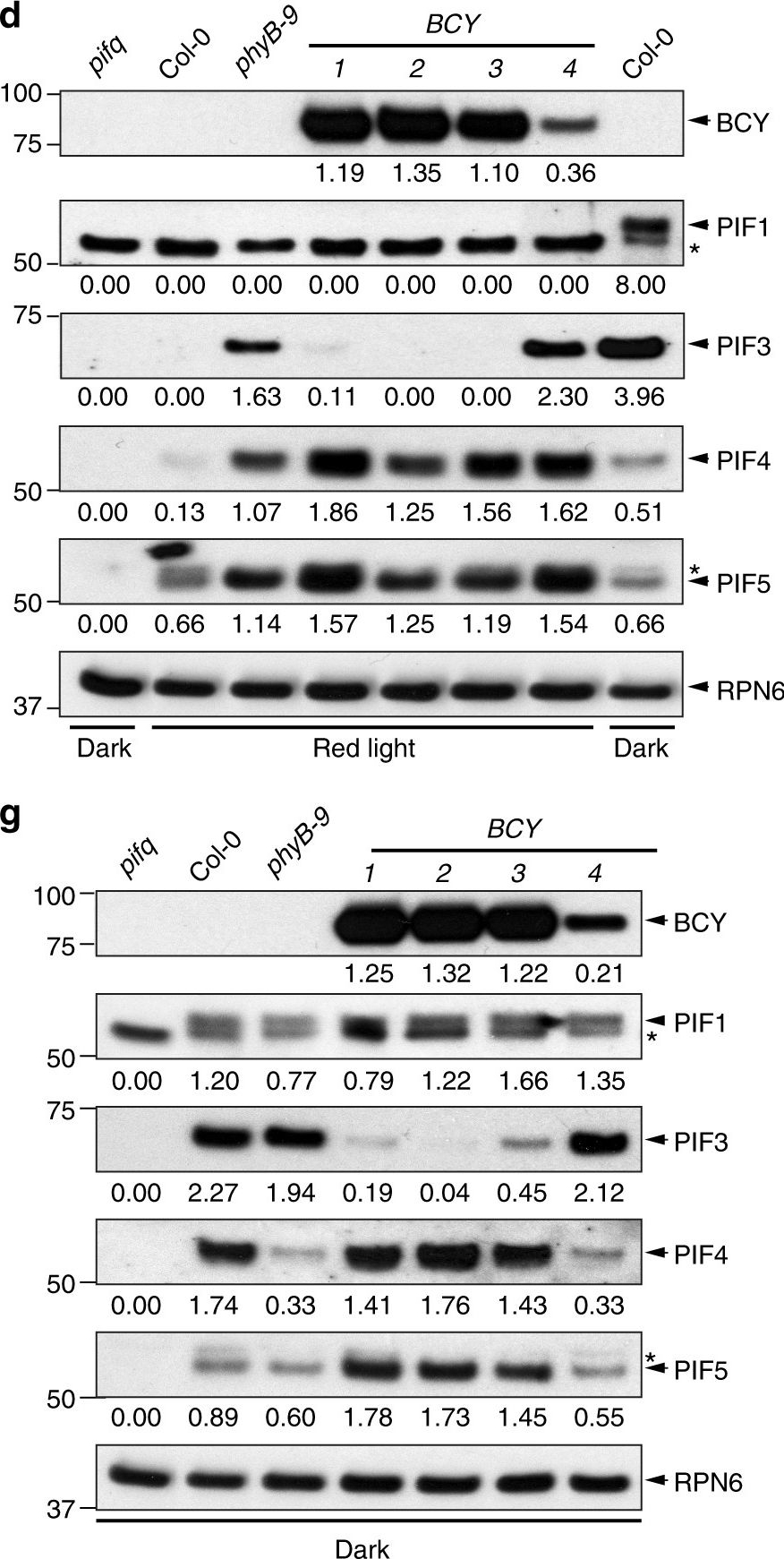1

Anti-PIF5 | Phytochrome interacting factor 5 (rabbit antibody)
AS12 2112 | Clonality: Polyclonal | Host: Rabbit | Reactivity: Arabidopsis thaliana
- Product Info
-
Immunogen: KLH-conjugated synthetic peptide derived from Arabidopsis thaliana PIF5, UniProt: Q84LH8, TAIR: AT3G59060
Host: Rabbit Clonality: Polyclonal Purity: Immunogen affinity purified serum in PBS pH 7.4. Format: Lyophilized Quantity: 50 µg Reconstitution: For reconstitution add 50 µl of sterile water Storage: Store lyophilized/reconstituted at -20°C; once reconstituted make aliquots to avoid repeated freeze-thaw cycles. Please remember to spin the tubes briefly prior to opening them to avoid any losses that might occur from material adhering to the cap or sides of the tube. Tested applications: Western blot (WB) Recommended dilution: 1 : 1000 (WB) Expected | apparent MW: 49.3 | 62 kDa - Reactivity
-
Confirmed reactivity: Arabidopsis thaliana Not reactive in: Physcomitrella patens, Solanum lycopersicum, Vitis vinifera
- Application Examples
-
Application example 
Total protein from Arabidopsis thaliana (10-20 µg) of 4-d-old dark grown Col-0, pif single, triple and quadruple mutants were extracted with the buffer described in Qiu et al. 2015 and denatured at 95°C for 5 min. were separated on 8 % Bis-Tris SDS-PAGE, and subsequently blotted to Nitrocellulose membrane using wet tank transfer. Blots were blocked with TBS containing 2% non-fat milk at room temperature for 1h. Primary anti-PIF5 antibodies were used in dilution of 1:1000 to TBS containing 2% milk. The incubation time was 14-20 hours at 4°C. After washing 4x5 min. with TBST at room temperature, the blots were incubated with HRP-conjugated secondary antibodies (1:5000) at room temperature for 1h. The blots were washed 4x10 min with TBST again and the signal was detected using highest sensitivity chemiluminescent substrate.
PIF5 signal is marked by red.
Courtesy od Dr. Yongjian Qiu, University of California-Riverside, USA
10 µg of total protein from 4 day old dark grown Arabidopsis thaliana seedligns extracted with hot buffer (Shen et al., Plant Cell. 2008;20(6):1586-602) were separated on 8 % SDS-PAGE and blotted 1h to PVDF using semi-dry. Blots were blocked with the blocking buffer from Protein Detector LumiGLO western blotting kit (KPL, Cat: 54-12-50) for 1h at room temperature (RT) with agitation. Blot was incubated in the primary antibody at a dilution of 1: 1 000 for overnight at 4 degree with agitation. The antibody solution was decanted and the blot was for 3 times for 5 min in the washing buffer from the same kit at RT with agitation. Blot was incubated in secondary antibody (anti-rabbit IgG horse radish peroxidase conjugated, (AS09 602 from Agrisera) diluted to 1:25 000 in for 2h at RT with agitation. The blot was washed as above and developed for 5 min with high sensitivity chemiluminescent substrate according to the manufacturer's instructions. Exposure time was 2 minute.
Higher % of a gel can separate better cross-reacting band and PIF5 protein.
Courtesy of Dr. Ling Zhu, University of Texas, USAApplication examples: 
Reactant: Arabidopsis thaliana (Thale cress)
Application: Western Blotting
Pudmed ID: 29199270
Journal: Nat Commun
Figure Number: 2D,G
Published Date: 2017-12-04
First Author: Qiu, Y., Pasoreck, E. K., et al.
Impact Factor: 13.783
Open PublicationThe C-terminal module of PHYB is biologically active to regulate hypocotyl growth and mediate PIF3 degradation. a Schematic illustration of the domain structures of PHYB-C-terminus-YFP (BCY). b Images of 4-day-old Col-0, phyB-9, and BCY-1 to BCY-4 transgenic lines grown in 10??mol?m?2?s?1 R light. c Hypocotyl measurements of Col-0, phyB-9, and BCY transgenic lines grown in 10??mol?m?2?s?1 R light. The boxes represent from 25th to 75th percentile; the bars equal to the median values. Samples with different letters exhibit statistically significant differences in hypocotyl length (ANOVA, Tukey’s HSD, P??40). d Immunoblots showing the steady-state levels of BCY, PIF1, PIF3, PIF4, and PIF5 in the indicated lines grown in 10??mol?m?2?s?1 R light. Dark-grown Col-0 and pifq samples were used as positive and negative controls for PIFs, and RPN6 was used as a loading control. The relative protein levels were normalized to the corresponding levels of RPN6 and are shown below each lanes. e Images of 4-day-old Col-0, phyB-9, and BCY-1 to BCY-4 transgenic lines grown in the dark. f Hypocotyl measurements of Col-0, phyB-9, and BCY transgenic lines grown in the dark. The boxes represent from 25th to 75th percentile; the bars equal to the median values. Samples with different letters exhibit statistically significant differences in hypocotyl length (ANOVA, Tukey’s HSD, P??40). g Immunoblots showing the steady-state levels of BCY, PIF1, PIF3, PIF4, and PIF5 in the indicated lines grown in the dark. Dark-grown Col-0 and pifq samples were used as positive and negative controls, respectively, for PIFs. RPN6 was used as a loading control. The relative protein levels were normalized to the corresponding levels of RPN6 and are shown below each lanes
- Additional Information
-
Additional information: PIF proteins are not that stable, therefore special precautions should be taken during extraction and whole procedure should be performed in as little light as possible (light green light).
Extraction of PIF proteins is described in Shen et al. (2007).Additional information (application): For detection of PIF5 please use the most sensitive detection reagent - Background
-
Background: PIF5 (Phytochrome interacting factor 5) is a transcription factor which acts negatively in the phytochrome B signaling pathway and regulates PHYB at post-transcriptional level.
Alternative protein names: AtbHLH65, bHLH65, bHLH065, Basic helix-loop-helix protein 65, PHYTOCHROME INTERACTING FACTORAS12 2112 3-LIKE 6, PIL6, Phytochrome interacting factor-like 6, Transcription factor EN 103. - Product Citations
-
Selected references: Pham et al. (2018). Dynamic regulation of PIF5 by COP1-SPA complex to optimize photomorphogenesis in Arabidopsis. Plant J. 2018 Aug 25. doi: 10.1111/tpj.14074. - Protocols
-
- Reviews:
-
This product doesn't have any reviews.



